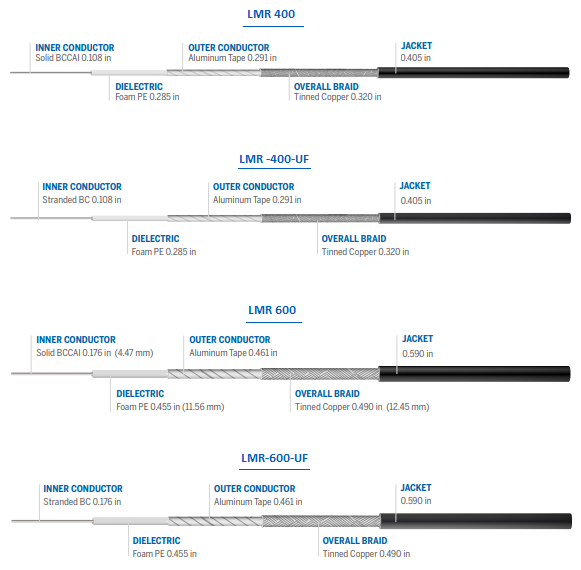Low Loss Coaxial Cables Feature Comparisons (400 and 600 Series)
The 400 and 600 series coaxial cables stand out for their sturdy performance and versatility. Coaxial cables are essential components in various applications, including ham radio, CB radio, and Wi-Fi.
The standard 400 series is known for its dependable signal transmission over intermediate distances, finding a compromise between flexibility and minimal signal loss. The 600 series offers even reduced attenuation, making it perfect for longer routes when signal strength is critical.
The Ultraflex variants come with a stranded center conductor and rubber jacket. Perfect for indoor and outdoor applications requiring multiple bending/flexing cycles. Both types are intended to serve a variety of applications, ranging from basic household installations to big industrial systems. Find a discussion on the same tackled here.
 LMR 400 and 600 Cable Comparisons
LMR 400 and 600 Cable ComparisonsThe feature table below provides a full comparison of their strengths and applicability for many scenarios, allowing you to make an informed decision for your individual needs.
| Feature | LMR400 | LMR 400 UltraFlex | LMR600 | LMR 600 UltraFlex |
|---|---|---|---|---|
Weight (lb/ft.) | 0.068 | 0.088 | 0.131 | 0.165 |
Overall Diameter (in) | 0.405 | 0.590 | ||
Min. Bend Radius (in) | 1.00 | 1.50 | ||
Impedance (Ohms) | 50/75 | |||
Maximum Frequency (GHz) | 8.0 | 6.0 | 6.0 | |
Shielding | >90dB | |||
Delay (ns/ft) | 1.2 | 1.17 | ||
Voltage Withstand (Volts DC) | 2500 | 4000 | ||
Jacket Spark (Volts RMS) | 8000 | |||
Operating Temperature (°F) | -40 to 185 | |||
Contact a signal specialist.
Related Articles
Overview of Coaxial Cable Design and Variations
Coaxial cables feature a dual-conductor design where two conductors are aligned as concentric cylinders with a shared central axis, separated by an insulating layer. Their broad application across diverse industries has spurred the creation of ...Coaxial Cable Construction and Signal Transmission Characteristics
For RF installations requiring coaxial cables, it is usually preferable that you maintain the attenuation loss as low as possible. Cable runs for RF installations should be maintained as short as possible to ensure minimal signal loss. Coaxial Cable ...Extending Range of 900 MHz Radio Devices for DSSS/ FHSS Radio Modems using Bidirectional Amplifiers
Describes in detail how to connect a Bi‐Directional 900MHz 5 Watt Amplifier for FHSS/ DSSS radio models to increase coverage area. It is particularly useful for SCADA applications. Boost the 900MHz radio signal and use a high-gain directional Yagi ...Cellular Band Antenna Options for Airlink Raven
Shown with omnidirectional antenna & lightning protection. Also includes variation for outdoor battery backup power UPS and a low-profile cellular band antenna.Alternate Versions of RF Connectors
Radio frequency (RF) connectors seek to transfer data across multi-megahertz radio frequencies with minimal data loss from reflection and dispersion, in a cost-effective manner. You may know SMA, RP-SMA, and N connectors. SMA are conventionally used ...